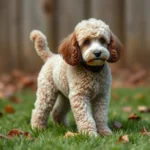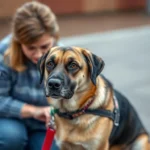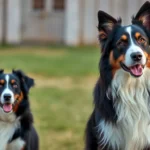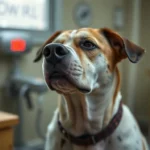
Teaching your dog tricks not only strengthens your bond but also provides them with mental stimulation and physical exercise. Among the myriad of tricks you can teach your furry friend, how to teach your dog to hug stands out as a heartwarming and fun activity. Utilizing positive reinforcement throughout this training process is crucial for fostering a positive experience for both you and your dog.
In this article, we will delve into the basics of dog training, prepare you for the training process, and provide a detailed step-by-step guide to help you teach your dog how to hug.
Understanding the Basics of Dog Training
Key Principles of Dog Training
Before diving into the specifics of teaching your dog to hug, it’s essential to grasp some of the key principles of dog training.
-
Positive Reinforcement vs. Negative Reinforcement: Positive reinforcement involves rewarding your dog for desired behaviors, making them more likely to repeat those behaviors. Negative reinforcement, on the other hand, involves removing an unpleasant stimulus when a desired behavior occurs. For effective training, prioritize positive reinforcement.
-
Consistency and Patience in Training: Dogs thrive on routine and consistency. Your training sessions should follow a structured approach, allowing your dog to learn at their own pace. Patience is key; some dogs may grasp concepts faster than others.
-
Importance of Timing in Rewards: Timing your rewards is crucial. Deliver the treat or praise immediately after your dog performs the desired action. This helps them associate the behavior with the reward, reinforcing the learning process.
Importance of Socialization
Socialization plays a pivotal role in shaping your dog’s behavior and responsiveness during training. A well-socialized dog is more likely to be confident and relaxed, making them more receptive to learning new tricks.
-
How Socialization Impacts Behavior: Socializing your dog exposes them to various people, animals, and environments. This exposure helps reduce anxiety and fear, which can hinder training efforts.
-
Tips for Socializing Your Dog Before Training: Start socializing your dog early in life. Gradually introduce them to different experiences, ensuring each interaction is positive. This will help create a more adaptable and confident dog that is ready to learn.
Setting Realistic Expectations
Every dog is unique, with different breeds and personalities influencing their learning capabilities.
-
Understanding Your Dog’s Breed and Personality Traits: Some breeds are naturally more eager to please, while others may be more independent. Consider your dog’s traits when setting training goals.
-
Patience and the Learning Curve: Remember that learning takes time. Be prepared for setbacks and celebrate small victories along the way.
Preparing for Training
Choosing the Right Environment
Creating an optimal training environment is crucial for success.
-
Finding a Quiet, Distraction-Free Space: Choose a location where your dog feels comfortable and is free from distractions. This will help them focus on the training.
-
The Significance of a Comfortable Training Area: Ensure that the training area is safe and familiar to your dog. This comfort will help them feel secure and more willing to engage in the training process.
Gathering Training Materials
Proper preparation includes having the right tools and materials on hand.
-
Types of Treats and Rewards: High-value treats are essential for effective training. These are treats your dog finds particularly enticing. Consider using small, soft treats or even pieces of their favorite food.
-
Suggested Training Tools: Training tools such as clickers can be beneficial for marking desired behaviors. A sturdy leash may also be needed to manage your dog during training sessions.
Establishing a Training Schedule
Setting a routine enhances the training experience.
-
Importance of Routine: Regular training sessions help reinforce learning. Aim for consistency in timing and duration.
-
Duration and Frequency of Training Sessions: Short, focused training sessions (10-15 minutes) are ideal for maintaining your dog’s attention. Aim for multiple sessions throughout the week.
Step-by-Step Guide to Teaching Your Dog to Hug
Teaching the Basic Commands
Before you start teaching your dog to hug, ensure they have a solid understanding of basic commands.
-
Review of Basic Commands: Commands such as sit, stay, and come are fundamental building blocks that will aid in more advanced training.
-
Importance of These Commands as a Foundation for Advanced Tricks: Having a strong foundation in basic commands will make it easier for your dog to learn new tricks, including hugging.
Introducing the Hug Command
Once your dog is comfortable with basic commands, it’s time to introduce the hug command.
-
Selecting a Verbal Cue for the Hug: Choose a clear verbal cue, such as “hug” or “cuddle.” Use this consistently to help your dog associate the word with the action.
-
Demonstrating the Action: If possible, have a demonstration dog or show your dog a visual of the hug. Seeing the action can help them understand what is expected.
Using Positive Reinforcement
Positive reinforcement is crucial to encourage your dog to embrace the hug command.
-
Timing and Frequency of Treats: Whenever your dog makes an attempt to hug, provide a treat immediately. This reinforces the behavior and encourages them to try again.
-
Highlighting the Importance of Praise and Encouragement: Verbal praise is just as important as treats. Use an enthusiastic tone to encourage your dog when they attempt the hug.
Breaking Down the Hug Action
To effectively teach your dog how to hug, break the action into smaller, manageable steps.
-
Step 1: Teaching Your Dog to Put Their Paws on Your Shoulders: Start with your dog in a sitting position. Encourage them to place their paws on your shoulders using treats as a lure.
-
Step 2: Encouraging Your Dog to Lean In for a Hug: Once they are comfortable placing their paws on your shoulders, guide them to lean in closer using the verbal cue and treats.
-
Step 3: Combining the Actions into One Cohesive Hug: Gradually combine the steps until your dog is performing the complete hug action on command.
Practicing the Hug
Practice is essential for mastering the hug trick.
-
Repetition and Consistency: Regular practice will help reinforce the hug behavior. Consistency in your training sessions is key to success.
-
Gradual Increase of Distance or Difficulty: As your dog becomes more proficient, challenge them by increasing the distance or adding distractions.
Troubleshooting Common Issues
Dog Not Responding to Commands
Sometimes, your dog may not respond as expected.
-
Potential Reasons for Lack of Response: This may be due to distractions or a lack of motivation. Assess your training environment and adjust accordingly.
-
Adjusting Training Techniques: Consider using higher-value treats or changing your approach to keep your dog engaged.
Overexcitement or Distraction
Managing distractions is crucial for maintaining focus during training.
-
Managing Distractions During Training: If your dog gets distracted, take a break and refocus. Gradually reintroduce distractions as your dog becomes more comfortable.
-
Tips for Keeping Your Dog Calm: Use calming techniques such as deep breathing or shorter training sessions to help your dog maintain focus.
Fear or Reluctance to Hug
If your dog seems hesitant or fearful, it’s important to address their concerns.
-
Understanding Your Dog’s Body Language: Pay attention to your dog’s body language. Signs of fear may include cowering or backing away.
-
Tips for Building Confidence in Shy or Fearful Dogs: Gradually introduce the hug concept at their pace. Use treats and praise to create positive experiences around the action.
Enhancing the Hug Experience
Adding Variations to the Hug
Once your dog has mastered the hug, you can add fun variations.
-
Different Types of Hugs: Experiment with side hugs, front hugs, or even group hugs with family members.
-
Incorporating Hugs into Playtime: Make hugs a part of playtime, turning it into a fun and interactive experience.
Making it a Fun Game
Transforming the hug command into a game can enhance learning.
-
Turning Hugs into a Fun Activity: Create a game where your dog has to perform the hug in exchange for treats or toys.
-
Incorporating Other Tricks with Hugs: Combine the hug with other tricks, such as “roll over” or “spin,” to make training more engaging.
Documenting Progress
Keeping track of your dog’s progress can be rewarding.
-
Keeping Track of Your Dog’s Progress: Maintain a training journal to log successes and setbacks. This can help you identify what works best.
-
Sharing Successes on Social Media: Documenting your journey can inspire others and lead to a supportive community of fellow dog lovers.
Conclusion
Teaching your dog to hug offers numerous benefits, from strengthening your bond to providing mental stimulation. Remember to practice patience and maintain a positive atmosphere during training. Celebrate small victories, as each step forward is a testament to the hard work you and your dog are putting in together. Enjoy the journey of teaching your furry companion this delightful trick!









